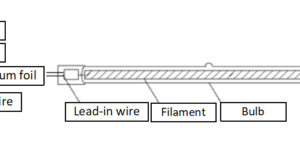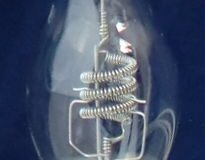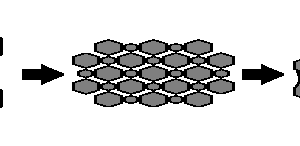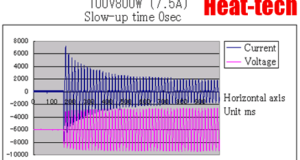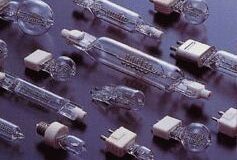할로겐 램프는 백열 전구와 마찬가지로 봉입 가스가 외부로 새지 않도록 밀봉된 밀폐 구조여야 합니다. 또한 할로겐 램프에서는 할로겐 사이클을 발생시키기 위한 조건으로 밸브의 온도는 250도 이상으로 할 필요가 있으므로 밸브에는 석영 유리 등의 내열 온도가 높은 유리가 사용됩니다. 석영 유리는 ...
Read More »4-5.할로겐 램프 석영 유리 밸브
석영 유리 밸브에 관하서 할로겐 램프의 밸브는 할로겐 사이클의 관계로 점등시 250℃ 이상의 내열 유리여야 합니다. 또한 밸브 내의 불활성 가스와 할로겐 가스는 1×10^5~4×10^5Pa의 고압으로 봉입되어 점등 중의 압력은 이 1.3배~7.0배에 달합니다. 이것으로부터 석영 유리가 사용됩니다. 석영 유리는 열팽창률이 매우 ...
Read More »4-4.텅스텐 열처리
텅스텐의 열처리에 관하서 텅스텐의 융점은 3422℃이며 금속에서 가장 융점이 높은 물질입니다. 가공 관점에서의 특성은 연성-취성 전이 온도가 높고 실온에서 저온 취성이 보입니다. 결정 입계의 결합 강도가 약하고 결정 입계에서 깨지기 쉽기 때문에 가공이 어려운 금속입니다. 텅스텐의 저온에서의 연성 개선으로서 레늄(Re)의 ...
Read More »4-3.필라멘트 코일에 관하서
필라멘트는 금속에서 가장 융점이 높은 텅스텐 사용합니다. 봉입하는 할로겐 가스에 의한 열손실을 억제하기 위해, 직선으로부터 개량해 코일 형상으로 한 필라멘트를 사용합니다. 필라멘트는 불활성 가스가 봉입된 밸브 내에 넣어지기 때문에 불활성 가스로 덮여 열 손실(필라멘트의 온도 저하)을 받습니다. 열손실은 필라멘트의 길이에 ...
Read More »4-2.할로겐 램프 가스의 종류와 메커니즘
할로겐 램프 가스 종류 할로겐 램프는 램프 내에 불활성 가스와 미량의 할로겐 가스를 봉입한 백열 전구입니다. 불활성 가스 불활성 가스에는 헬륨(He 4.00g/mol), 네온(Ne 20.18g/mol), (질소(N2 28.02/mol)), 아르곤(Ar 39.95g/mol), (이산화탄소(CO2 44.01g/ mol)), 크립톤(Kr 83.80/mol), 크세논(Xe 131.29g/mol), 라돈(Rn 222.000/mol)이 있습니다. 헬륨·네온·아르곤·크립톤·크세논·라돈은 공기 ...
Read More »4-1.할로겐 램프까지의 발전 경위
탄소 필라멘트의 발전 할로겐 램프는 백열 전구에서 발전했습니다. 초기 발열 전구의 필라멘트는 카본 필라멘트가 사용되고 있었습니다. 오스뮴이나 탄탈 등 금속의 필라멘트의 개발이 행해지고 있었습니다만, 가격이나 교류 점등시의 문제로부터 일반 보급에는 이르지 않았습니다. 미국 W.R. Whitney 박사는 전구 흑화의 원인이 증발된 ...
Read More » HEAT-TECH 최선의 기술 온라인(on-line) 샵
HEAT-TECH 최선의 기술 온라인(on-line) 샵 
